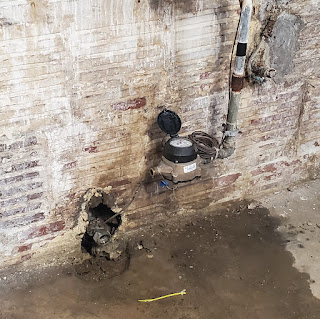Now that we're almost a month in, I feel like I should at least check in and share some updates on what's happening at the Akron almost-mansion.
I don't know that I'm going to document every element of the Great Akron Home Renovation and Reconstitution Project, but if I do, I'm absolutely going to have to come up with a snappier title for it. Until then, GAHRRP it is.
We are currently in the "Planning for Progress" phase. Here, "Planning for Progress" is my shorthand for the fact that nothing is visibly happening at our new house. Instead, through a series of phone calls with contractors, on site consultations with contractors, follow up conversations with contractors, and disappointing news from contractors, we are laying the groundwork for progress. We are planning for progress to happen in the form of physical work that will eventually commence on the physical house. This current phase then is not an exciting one, especially for someone who hates talking on the phone, but it has to be done.
As a side note, I'll mention that every contractor apparently has a special gift for finding more things wrong than any homeowner or buyer could rightly be expected to foresee. This is good in its way. You want contractors who can identify issues - even if they're things you didn't notice or plan for - and fix them. It's just a little disappointing as it adds an extra step back for every step forward. This phenomenon typically manifests itself in the form of a contractor explaining something along the lines of, "I can't fix the thing you've asked me to fix until you first fix the thing I just found that you, poor homeowner, didn't even imagine might be an issue".
Getting the water turned on is a perfect example of this. On Friday a technician from the Akron utilities came out to turn on our water. When he went to the basement to check the meter, he informed me that the pipe going into the meter was too small and he couldn't get us water until that was addressed. When I asked if that was something he could do, he said "No", explaining that those fittings and connections were the homeowner's responsibility. I'd need to call a plumber. So, water service status: rescheduled.
Still, things are happening. The electricity is on and in my name. The gas is turned back on. Water is coming soon, and with it the promise of learning about everything that's wrong with our ancient and long idle steam heating system. I've even erected a mailbox to start collecting all the home equity line of credit offers, bathroom remodeling postcards, and gutter replacement flyers that are sure to come.
This mail receptacle, informally christened "the sketch mailbox", is admittedly unworthy of the vision and aspirations we have for this house (To be frank, it's presence is an insult.). I justify its deployment based on its low cost ($49.99), ease of installation, and the fact that it was 15 degrees out and we needed something.
Other notable wins of late include figuring out what the mystery niche in the bathroom was (combination night light and electrical outlet) and learning that the plumber thinks he can rebuild the faucet on the salvaged pink sink we bought for our pink first floor half-bath (The same plumber is taking some measurements to confirm that the pink Kohler toilet we're eyeing will fit in the same pink bathroom). We also have identified a contractor for the kitchen (a big deal), figured out where the mystery water that caused the kitchen ceiling to collapse was coming from (the roof, natch), and found the secret room of doors in the basement that included, among other things, the original wooden screen doors (thank you previous owners).
As with my previous house post, I feel like it's fitting to sign off with a picture of the backyard. There's a lot of things that make this house special to us, but the parcel it's on and the natural view it offers is right near the top of the list. After watching a roofing contractor bravely step out onto the flat garage roof connected to the house, I bravely did the same. We're hopeful this roof will eventually be a space where we can gather to relax and enjoy the view in better weather. Until then, here's the view as of Feb 14, 2025.






Comments
Post a Comment